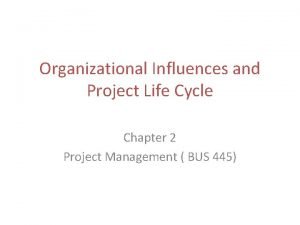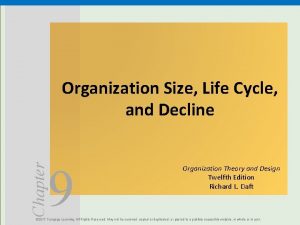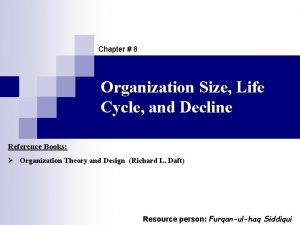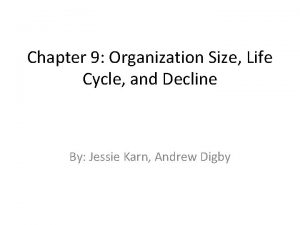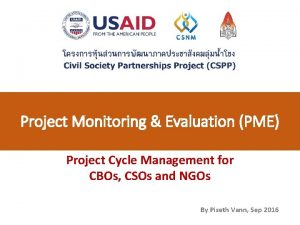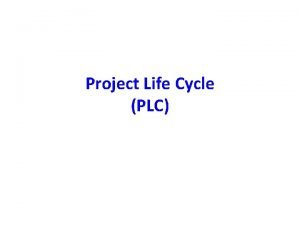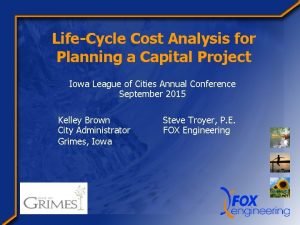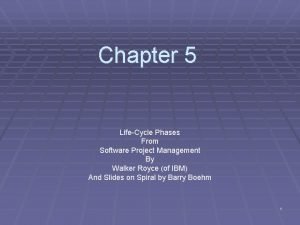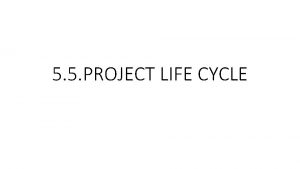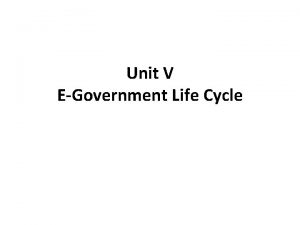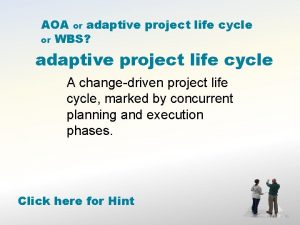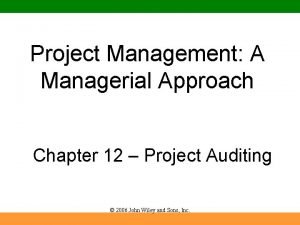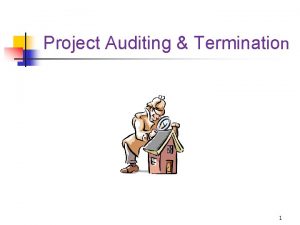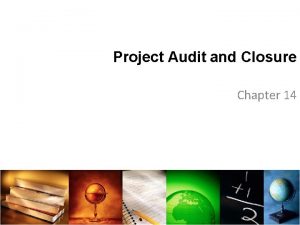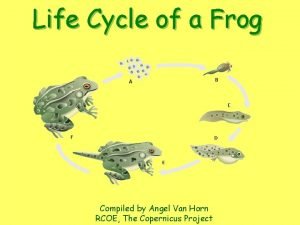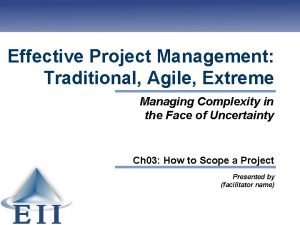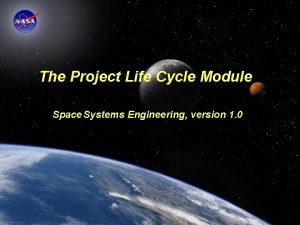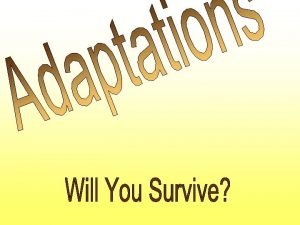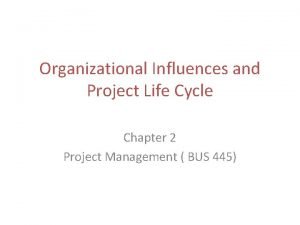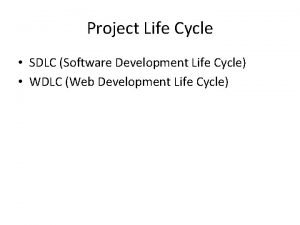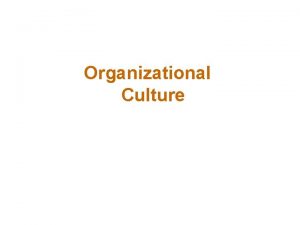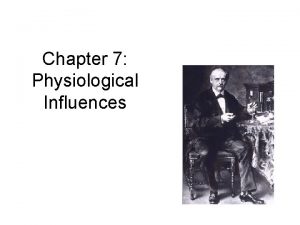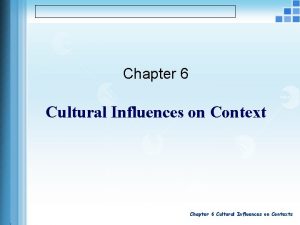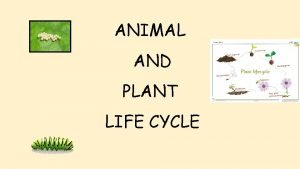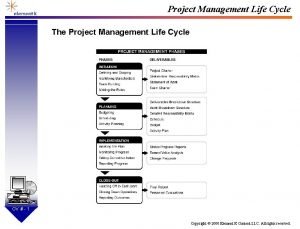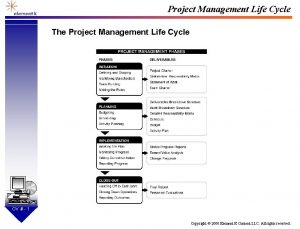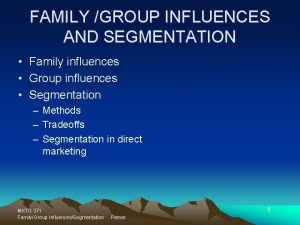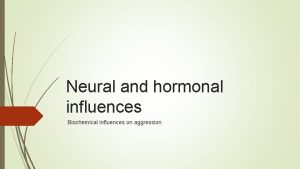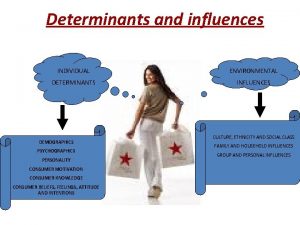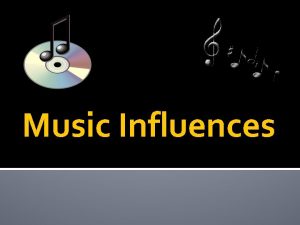Organizational Influences and Project Life Cycle Chapter 2


























- Slides: 26

Organizational Influences and Project Life Cycle Chapter 2 Project Management ( BUS 445)

Organizational influences • What are Organizational influences? Organizational influences directly affect a project’s success—either positively or negatively. These influences include the organization’s culture, its structure and its general style.

Organizational Culture: • Culture is an important consideration because it alone can determine the success of a project. • Organizational culture is shaped by the common experiences of members of the organization and most organization have developed unique cultures over time by practice and common usage.

Organizational communications • Project management success in organization is highly dependent on an effective organizational communication style, especially in the face of globalization of the project management profession.

Organizational Structures : • Firm strcture is another organizational influence. It might be: * a functional organization * a projectized organization * a matrix organizations

Functional Organization • This organization is the most common form of an organization. Organizational departments are grouped by areas of specialization within different functions. In these organizations, projects generally occur in silo environments, i. e. within the same function. Team members complete the project work over and above their responsibilities to normal departmental work. Communication primarily occurs within the same function.

Functional Organization

Projectized Organization • In a project-centric organization environment, the entire company is organized by projects, and the project manager is in control of the projects. Individuals or employees are assigned to projects and report into a project manager. Once the project is over, they need to be assigned to another project. Communication primarily occurs within the same project.

Projectized Organization

Matrix Organizations In a matrix organization, the team members report into two bosses: the functional manager and the project manager. Communication goes from team members to both bosses. The matrix organization is created to get the best potential from both functional and project-centric types of organizational structure. Team members have departmental work and they also do project work.

Weak Matrix Organization

Balanced Matrix Organization

Strong Matrix Organization

Organizational Influences

Project Stakeholder and Governance • Project Stakeholders *All members of the project team as well as all interested entities that are internal or external to the organization or positive and negative and performing and advising stakeholders in order to determine the project requirements and expectations of all parties involve. *Stakeholders have a varying level of responsibilities and authority when participating on project

Project Stakeholder and Governance • Project Success *The success of the project should be measured in terms of completing the project within the constraints of scope, time, cost, quality, resources, and risk as approved between the project manager and senior management. *Project manager is responsible and accountable for setting realistic and achievable boundaries for the project within the approved baseline.

Project Stakeholder and Governance • Project Team *Includes the project manager and the group of individuals who act together in performing the work of the project to achieve its objective *Project team includes: project management staff , project staff, supporting experts, user and customer representatives, sellers, Business partner members.

Project Stakeholder and Governance § Composition of project teams: *It based on factors such as organization culture, scope, and location. *Basic project team composition: - Dedicated -Part-time

Project Life Cycle • Project life cycle It’s series of phases that a project passes through from its initiation to closure. Project life cycle defines: - What technical work to do in each phase - What deliverables are to be generated in each phase and how they are reviewed, verified and validated - Who is involved in each phase - How to control and approve each phase

The Project Life Cycle Structure

Common characteristics for life cycles: • - Phases are generally sequential - Cost and staffing levels are low at the start, peak during intermediate phase and drop rapidly on closing phase. - Highest level of uncertainty, greatest risk of failing to achieve the objectives at the start of project - Highest influence of stakeholders on project's product and final cost at the start of project because the cost of change increase as project progressing.

Characteristics of The Project Life Cycle

Project Phases Project may be divided into many number of phases • A project phase is a collection of logically related project activities that culminated in the completion of one or more deliverables. • The phase structure allows the project to be segmented into logical subsets for ease of management, planning, and control. • For reason of size, complexity, level of risk and cash flow constraints, project phases can be subdivided in to sub phases aligned with one or more specific deliverables for monitoring and control.

Project Phases v Phase-to-Phase Relationship When projects have more than one phase, the phases are part of generally sequential process designed to ensure proper control of the project and attain the desired product, service or results. § Sequential relationship: The phase starts only when the previous phase is completed. § Overlapping relationship: A phase starts prior to completion of the previous one.

Project Phases v Predictive Life Cycles § known as fully plan driven § They are ones on which the project scope, and the time and cost required to deliver that scope as early in the project life cycle as practically possible.

Project life cycle and product life cycle v Product life cycle starts with the business plan, through ideas to product, ongoing operations and product divestment. v. The project life cycle goes through a series of phases to create the product.
 Project life cycle structures
Project life cycle structures Influences of organizational structures on projects
Influences of organizational structures on projects Organizational life-cycle stages and hr activities
Organizational life-cycle stages and hr activities Organizational life cycle stages
Organizational life cycle stages Organizational decline stages
Organizational decline stages Organizational life cycle of apple
Organizational life cycle of apple Pme project management
Pme project management Chapter 5 two-cycle and four-cycle engines answers
Chapter 5 two-cycle and four-cycle engines answers Life cycle of medium mass star
Life cycle of medium mass star Project life cycle plc
Project life cycle plc Capital project lifecycle
Capital project lifecycle Construction phase in software engineering
Construction phase in software engineering Pre investment phase in project life cycle
Pre investment phase in project life cycle E governance life cycle
E governance life cycle Adaptive project life cycle
Adaptive project life cycle Project life cycle
Project life cycle Project audit life cycle
Project audit life cycle Project termination steps
Project termination steps Project audit objectives
Project audit objectives Tadpole angel
Tadpole angel Project life cycle
Project life cycle Diagram of project life cycle
Diagram of project life cycle Space project phases
Space project phases Life cycle of nebula
Life cycle of nebula Everything that surround us is called
Everything that surround us is called Influences on parliament
Influences on parliament Chapter 17 the beginning of the life cycle
Chapter 17 the beginning of the life cycle
